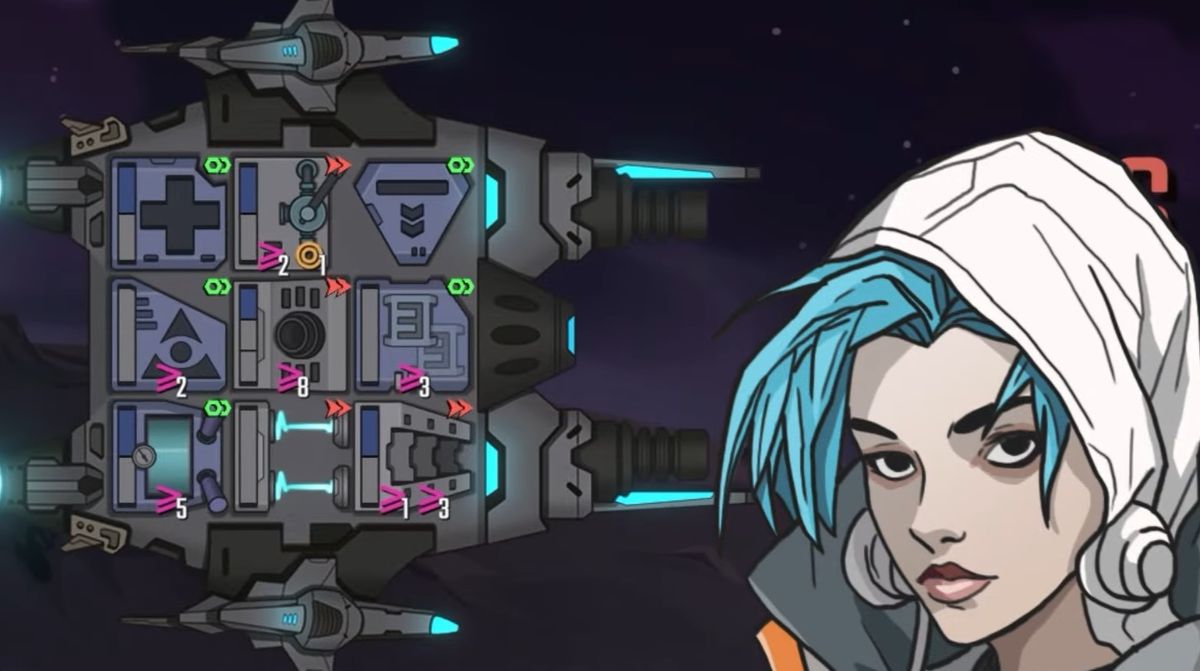You have to wonder whether the creators of Lonestar were cursing their luck last November, when turn-based, space duel roguelike Cobalt Core was released. Lonestar, you see, is a turn-based, space duel roguelike, and if the two games don’t exactly look like twins, they could certainly be first cousins. Both centre on nose-to-nose spaceship battles where you pump out numbered damage in narrow columns and shift sideways to avoid incoming fire. Both involve pre-emptively neutralising the enemy’s signalled attack with randomised resources. Thus Lonestar seems to beg the question: if you’ve already played Cobalt Core (which you should) is there a need for this as well?
Thankfully, the short answer is yes. Lonestar’s early access release already has enough about it to differentiate itself not only from Cobalt Core but the teetering pile of recent turn-based roguelikes hustling for recognition around it. While of course it needs more bulk and refinement before a future 1.0 release, it’s sufficiently distinguished and piquant with its tactical demands to suck up free time like a mini black hole.
The main difference between Lonestar and Cobalt Core—aside from Lonestar presenting its skirmishes horizontally rather than vertically—is that Lonestar isn’t a card-based game in the vein of Slay the Spire. Or at least, not quite. True, at the start of each turn, a spread of rectangles appears at the base of the screen, but these merely represent energy resources that you then allocate to units fixed to your vessel, choosing which to power up and how much for optimum results. In a way, it’s a typical card-based roguelike in reverse, in that all abilities are constantly available, but the number of points you have to spend is in randomised flux.
You could also say that Lonestar is a deck-builder, except the deck in question is that of your portly bounty-hunting craft, comprising a three-by-three grid. Your combat abilities are determined by the attack and support units you place in those spaces, a selection that grows with post-battle rewards and shopping trips. Before long in each run you’ll own more units than you can accommodate at once, so you might re-spec for each bounty, or seek a dependable all-round solution. Sometimes, merely swapping the positions of units makes a difference, as certain types interact with those beside them. Shuffling your deck, so to speak.
Instead of merely playing cards in battle, then, you fill coloured slots on each unit with energy, which charges it up. In basic terms, if you place a three-point energy resource into the slot of a cannon, it will fire for three points of damage at the end of the turn. If the unit has a second slot, you can add another energy card to increase that output. To complicate matters, though, slots and energy come in three colours: white, blue and orange. Orange energy can be loaded into any slot, blue into blue or white, and white into white only. If a unit has orange slots, then, you might not get to use it as often as you’d like.
Support units, meanwhile, might generate higher value or quality energy when you power them up, or add passive boosts to surrounding units on certain conditions. And all but the most bog-standard weapons can be given extra oomph if you, say, load only white energy or load two energy resources of the same value. As in any good strategy roguelike, there are pros and cons with every choice, and satisfaction comes from finding the optimum balance in a turn, triggering status effects to boost damage output, rather than simply powering up your fanciest cannons as much as possible.
Another part of that balance involves distributing your outgoing wrath across the three rows of your ship to counter whatever’s coming from the opposite direction. Unlike Cobalt Core, movement is very limited in Lonestar, with only one sideways shift allowed per turn, and only as long as you have fuel in your tank. So when your opponent charges their weapons at the start of a turn, and shows you exactly how much damage they can cause, you largely have to fight firepower with firepower. At the end of a turn, both ships unleash their lasers and whoever has the bigger number in each row lands a blow, with the difference between the two determining the damage. Ideally, of course, you want to win all three rows, but compromise is often unavoidable. You may even opt to lose them all by a narrow margin, rather than win two and leave yourself open to massive damage in the third.
In short, there’s plenty to wrap your thinking gear around here, and beyond the basics Lonestar is awash with sticky choices and devilish turns: a range of upgrade possibilities, enemy ships with unusual units that can play havoc with your plans, two starting ships (essentially different characters) with bespoke play styles and units, a wide range of pilots which come with unique passive bonuses, and several extra levels of challenge after your first completion. Doubtless, more will be required in due course, but for the beginnings of early access, what’s on offer here isn’t to be sniffed at.
What is undernourished, however, and an area where Cobalt Core is streets ahead, is the game’s presentation. Lonestar is all a bit dry and short on personality. The sci-fi wild west theme implied by the title and some twangy old-time guitar music feels half-forgotten, and while the ship designs and laser effects are reasonably smart, everything around them is as sparse as space itself. Enemy pilots, for example, remain anonymous, occasionally emitting speech bubbles from inside the hull of their vessel without so much as an accompanying portrait. Inter-battle events are described in blocks of text, when an illustrative picture—as in Slay the Spire—might paint a thousand words, or at least a few hundred.
It doesn’t help that the English script isn’t up to standard, stylistically and functionally. Explanations for units are often poorly worded or inaccurate, including a mix up between rows and columns. Much of the key vocabulary—such as ‘energy’, ‘strength’ and ‘power’—is also overly vague and similar. Sometimes it’s quicker just to equip something and see how it works for yourself. Lore, meanwhile, feels flat and throwaway, and hints of a fun universe where humans rub shoulders with tree people and talking cats are never given much context.
There are, as you might expect at this stage, some balance issues too. A single run covers 12 battles, split into three levels, with every fourth encounter a boss. What tends to happen, though, is that regular enemies roll over and explode without much of a fight, while bosses put up eye-watering numbers that belong in a different galaxy. It’s still easy enough to complete a run since you can retreat from battle before an inevitable defeat and adjust your deck before going again, and it can be very pleasing to finally finagle a loadout that counters an opponent’s super power. But it’s a shame the difficulty curve isn’t smoother, forcing you to test your mettle more before placing major hurdles in your way.
Hopefully, these issues will all be addressed as further content arrives during this early access phase, and obvious comparisons with certain other recent games can be banished once and for all. For now, Lonestar has established strong foundations with its core systems, providing strings of strategic choices to fiddle with. As space odysseys go, it’s a promising start.


